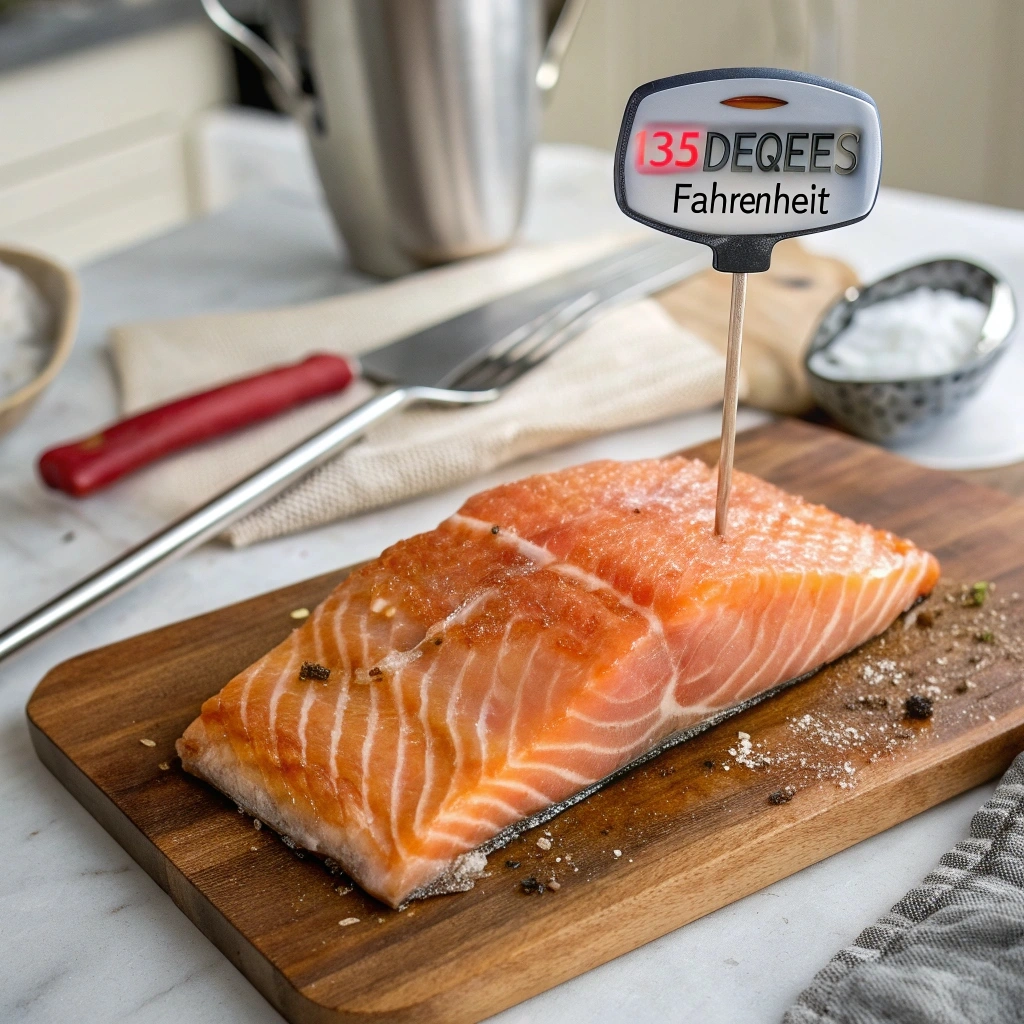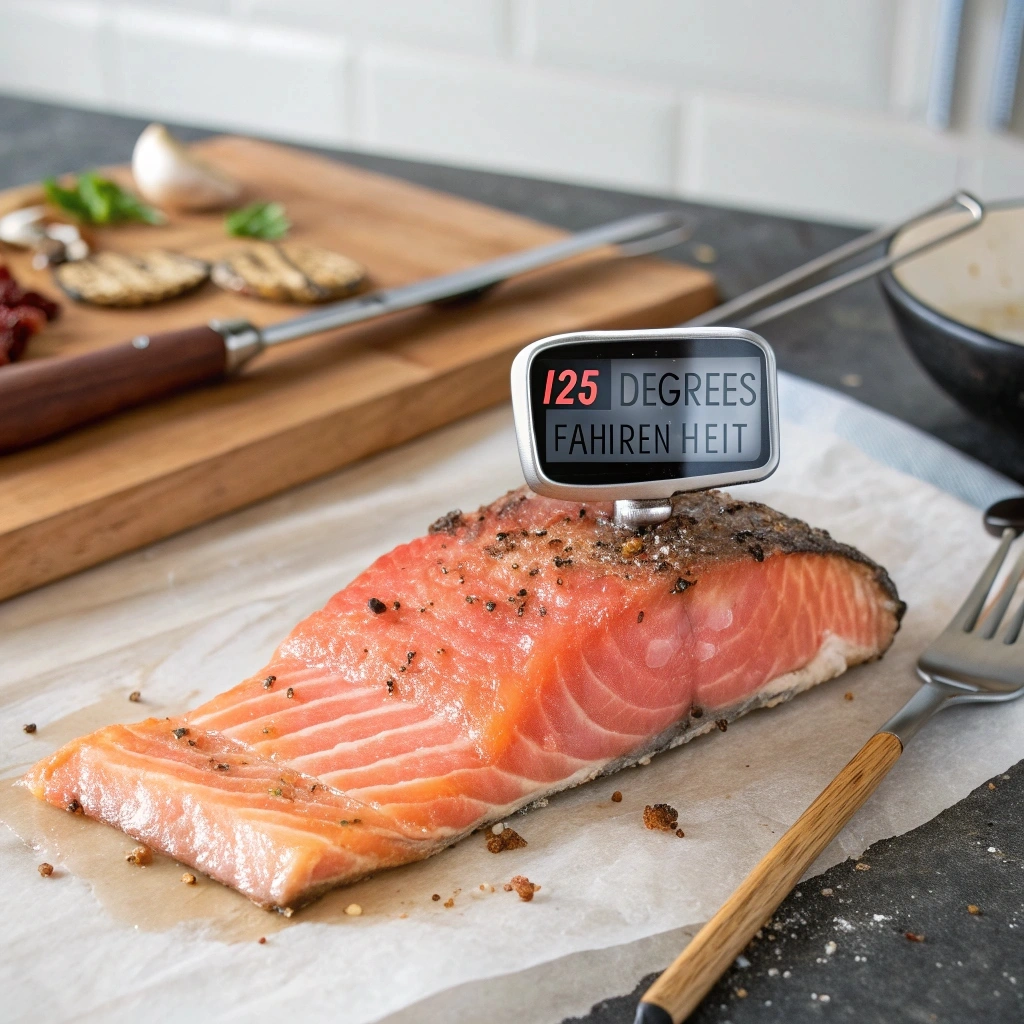Salmon Internal Temp: The Incredible Secret to 3 Amazing Dishes
Salmon internal temp is crucial for perfectly cooked fish. Understanding it ensures a safe and delicious meal every time. This guide reveals the secrets to achieving the ideal salmon internal temp.
Introduction to Salmon Internal Temp
Salmon internal temp is the key to unlocking the best flavor and texture of this healthy fish. Whether you prefer your salmon flaky, moist, or somewhere in between, knowing the correct internal temperature is essential. Proper cooking also ensures food safety. Failing to reach the right salmon internal temp can lead to unpleasant results, including dryness or, worse, a risk of foodborne illness. Therefore, mastering this technique is important for any home cook.
Understanding Salmon Internal Temp: The Basics
The recommended salmon internal temp, according to food safety guidelines, is 145°F (63°C). This temperature ensures that any harmful bacteria are eliminated. However, many chefs and home cooks prefer a slightly lower internal temperature for optimal texture and moisture. A range of 125°F to 140°F (52°C to 60°C) is often used, depending on personal preference. The “carryover cooking” effect should also be considered. The salmon’s internal temp will rise a few degrees after it is removed from the heat.
Why Internal Temp Matters
Knowing the salmon internal temp is vital for both taste and safety. Overcooked salmon becomes dry and tough. Undercooked salmon can be a health hazard. Using a reliable meat thermometer is the easiest way to guarantee that your salmon reaches the perfect internal temp. This simple step can significantly improve the outcome of your cooking efforts. The nuances of salmon’s texture change dramatically within a small temperature range. Understanding this is what separates a good cook from an amazing one.
Tools for Measuring Salmon Internal Temp
A digital instant-read thermometer is the best tool for accurately measuring the salmon internal temp. These thermometers provide quick and precise readings. Insert the thermometer into the thickest part of the salmon fillet, avoiding any bones. Make sure the thermometer is clean before use. Regular calibration of your thermometer is also a good practice to ensure accuracy. Consider investing in a thermometer with a thin probe; this minimizes the impact on the salmon’s delicate texture.
Image Placeholder: alt text: Measuring salmon internal temp with a digital thermometer
Achieving the Perfect Salmon Internal Temp: Cooking Methods
Various cooking methods affect the final salmon internal temp. Each technique requires slightly different approaches to ensure even cooking and optimal results. Understanding how each method impacts the internal temp is crucial for achieving the desired level of doneness. The method you choose often depends on the type of salmon you are using, and the flavor profile you are aiming for.
Baking Salmon
Baking salmon is a simple and healthy cooking method. Preheat your oven to 375°F (190°C). Place the salmon on a baking sheet lined with parchment paper. Bake for 12-15 minutes, or until the salmon internal temp reaches 125°F to 140°F (52°C to 60°C), depending on your preference. Check the temp regularly. Baking delivers a tender, flaky result. Adding a touch of citrus or herbs can enhance the flavor during baking.
Pan-Seared Salmon
Pan-searing salmon creates a delicious crispy skin. Heat oil in a skillet over medium-high heat. Place the salmon skin-side down in the hot pan. Cook for 4-5 minutes, or until the skin is golden brown and crispy. Flip the salmon and cook for another 3-4 minutes, or until the salmon internal temp reaches your desired level. Careful monitoring is essential to avoid overcooking. Patting the skin dry before searing ensures maximum crispiness. A cast iron skillet is ideal for achieving even heat distribution.
Grilled Salmon
Grilling salmon adds a smoky flavor to the fish. Preheat your grill to medium heat. Place the salmon on the grill grates, skin-side down if possible. Grill for 3-5 minutes per side, or until the salmon internal temp reaches your desired level. Use a grill basket or foil to prevent the salmon from sticking. Grilled salmon is perfect for summer meals. Marinating the salmon before grilling adds depth of flavor.
Poached Salmon
Poaching salmon is a gentle cooking method that results in moist and tender fish. Bring a pot of water or broth to a simmer. Gently place the salmon in the liquid. Poach for 8-10 minutes, or until the salmon internal temp reaches your desired level. Poached salmon is excellent for salads and light meals. Using flavorful broth or wine enhances the poached salmon.
Sous Vide Salmon
Sous vide is a precise cooking method that ensures consistent results. Preheat a water bath to your desired salmon internal temp, typically between 125°F to 140°F (52°C to 60°C). Place the salmon in a vacuum-sealed bag. Cook in the water bath for 30-45 minutes. Sous vide salmon is incredibly tender and evenly cooked. A quick sear in a hot pan after sous vide enhances the texture and appearance.
Image Placeholder: alt text: Perfectly grilled salmon with a digital thermometer inserted

Factors Affecting Salmon Internal Temp
Several factors can influence the cooking time and the final salmon internal temp. These include the thickness of the fillet, the starting temperature of the salmon, the accuracy of your oven or grill, and even the elevation at which you are cooking. Understanding these factors helps to adjust cooking times and achieve the desired results.
Thickness of the Fillet
Thicker salmon fillets require longer cooking times to reach the desired salmon internal temp. Thin fillets cook more quickly. Adjust the cooking time based on the thickness of the salmon. Use a thermometer to check the temp at the thickest part of the fillet. A visual inspection can also help; the salmon should flake easily when gently pressed.
Starting Temperature
Salmon that starts at room temperature will cook more evenly than salmon that is taken directly from the refrigerator. Allow the salmon to sit at room temperature for 15-20 minutes before cooking. This will help ensure that the salmon cooks evenly and reaches the perfect salmon internal temp. However, be mindful of food safety; don’t leave it out for too long.
Oven and Grill Calibration
Ovens and grills can vary in temperature. Use an oven thermometer or a grill thermometer to ensure accurate temperature readings. Calibrate your oven or grill as needed. Consistent temperatures are crucial for achieving the perfect salmon internal temp. Regular calibration ensures consistent results and prevents unexpected cooking times.
Elevation
At higher elevations, water boils at a lower temperature, which can affect cooking times. If you live at a high elevation, you may need to adjust the cooking time or temperature. It’s best to consult resources specific to high-altitude cooking for precise adjustments.
Tips for Achieving the Best Salmon Internal Temp
Here are some additional tips to help you achieve the best salmon internal temp every time:
Use a Reliable Thermometer
Invest in a high-quality digital instant-read thermometer. Ensure that it is calibrated properly. A reliable thermometer is the most important tool for achieving the perfect salmon internal temp. Consider a thermometer with an alarm feature to alert you when the salmon reaches your desired temperature.
Don’t Overcrowd the Pan or Grill
Overcrowding the pan or grill can lower the temperature and result in uneven cooking. Cook the salmon in batches if necessary. This will help ensure that each piece of salmon cooks evenly and reaches the desired salmon internal temp. Allow enough space for heat to circulate evenly around each piece.
Let the Salmon Rest
Allow the salmon to rest for a few minutes after cooking. This allows the juices to redistribute, resulting in a more moist and flavorful piece of fish. Cover the salmon loosely with foil while it rests. This resting period is crucial for achieving optimal texture.
Consider Carryover Cooking
As mentioned earlier, carryover cooking continues after the salmon is removed from heat. Take this into account when determining when to pull the salmon from the oven, pan, or grill. Aim for a few degrees below your target temperature.
Image Placeholder: alt text: A close-up of moist, flaky salmon after resting, perfect salmon internal temp
Common Mistakes to Avoid with Salmon Internal Temp
Avoiding these common mistakes will help you cook salmon to perfection:
Overcooking the Salmon
Overcooking is the most common mistake when cooking salmon. This results in dry, tough fish. Use a thermometer to monitor the salmon internal temp closely. Remove the salmon from the heat when it reaches your desired temperature. Err on the side of caution; it’s better to slightly undercook the salmon than to overcook it.
Not Using a Thermometer
Guessing the salmon internal temp is a recipe for disaster. A thermometer is essential for ensuring that the salmon is cooked to the correct temperature. Invest in a reliable thermometer and use it every time you cook salmon. Relying solely on visual cues is unreliable.
Cooking from Frozen
Cooking salmon from frozen can result in uneven cooking. Thaw the salmon completely before cooking. This will help ensure that the salmon cooks evenly and reaches the perfect salmon internal temp. If you must cook from frozen, adjust the cooking time significantly.
Ignoring Carryover Cooking
Remember that the salmon internal temp will continue to rise after it is removed from the heat. Take this into account when determining the final cooking time. Remove the salmon from the heat when it is slightly below your desired temperature. This is especially important for thicker fillets.
Using the Wrong Type of Thermometer
While a meat thermometer is essential, the type matters. An instant-read thermometer is ideal for quick and accurate readings. Oven-safe thermometers can be left in the salmon during baking, but may not be as accurate for a quick check.

Delicious Salmon Recipes Using the Perfect Internal Temp
Here are a couple of recipes to utilize your knowledge of salmon internal temp:
Baked Lemon Herb Salmon
Ingredients:
4 salmon fillets
2 tablespoons olive oil
2 cloves garlic, minced
1 lemon, sliced
Fresh herbs (dill, parsley, thyme)
Salt and pepper to taste
Instructions:
Preheat oven to 375°F (190°C).
Place salmon on a baking sheet lined with parchment paper.
Drizzle with olive oil and sprinkle with garlic, salt, and pepper.
Top with lemon slices and fresh herbs.
Bake for 12-15 minutes, or until the salmon internal temp reaches 125°F to 140°F (52°C to 60°C).
Let rest for a few minutes before serving.
Serve with a side of roasted vegetables for a complete and healthy meal.
Pan-Seared Salmon with Asparagus
Ingredients:
4 salmon fillets
1 tablespoon olive oil
1 bunch asparagus, trimmed
Salt and pepper to taste
Lemon wedges for serving
Instructions:
Heat olive oil in a skillet over medium-high heat.
Season salmon with salt and pepper.
Place salmon skin-side down in the hot pan.
Cook for 4-5 minutes, or until the skin is golden brown and crispy.
Flip the salmon and add asparagus to the pan.
Cook for another 3-4 minutes, or until the salmon internal temp reaches 125°F to 140°F (52°C to 60°C) and asparagus is tender.
Serve with lemon wedges.
A squeeze of fresh lemon juice brightens the flavors.
Honey Garlic Glazed Salmon
Ingredients:
4 Salmon Fillets
2 Tablespoons Honey
2 Tablespoons Soy Sauce
1 Tablespoon Sesame Oil
2 Cloves Garlic, Minced
1 Teaspoon Ginger, Grated
Sesame Seeds and Green Onions for Garnish
Instructions:
Preheat oven to 375°F (190°C).
In a small bowl, whisk together honey, soy sauce, sesame oil, garlic, and ginger.
Place salmon fillets on a baking sheet lined with parchment paper.
Brush the honey garlic glaze evenly over the salmon.
Bake for 12-15 minutes, or until the salmon internal temp reaches 125°F to 140°F (52°C to 60°C).
Garnish with sesame seeds and chopped green onions before serving.
Image Placeholder: alt text: A plate of perfectly pan-seared salmon with crispy skin
Exploring Different Types of Salmon and Their Ideal Temperatures
The type of salmon can also influence the ideal internal temperature and cooking time. Different varieties have varying fat content and textures, which can affect how they cook and taste.
Sockeye Salmon
Sockeye salmon is known for its deep red color and rich flavor. It has a higher fat content than some other varieties, which helps keep it moist during cooking. The ideal internal temperature for sockeye salmon is typically between 125°F to 130°F (52°C to 54°C) to maintain its tender texture.
King Salmon (Chinook)
King salmon, also known as Chinook, is the largest and often considered the most prized type of salmon. It has a very high fat content, which makes it incredibly flavorful and moist. It’s best cooked to an internal temperature of 125°F to 135°F (52°C to 57°C) to prevent it from drying out.
Coho Salmon (Silver Salmon)
Coho salmon has a milder flavor than sockeye or king salmon. It’s also leaner, so it can be more prone to drying out if overcooked. Aim for an internal temperature of 130°F to 135°F (54°C to 57°C) to keep it moist and tender.
Pink Salmon (Humpy)
Pink salmon is the smallest and most abundant type of salmon. It has a lower fat content and a more delicate flavor. It’s best cooked to an internal temperature of 135°F to 140°F (57°C to 60°C) to ensure it’s fully cooked without becoming too dry.
Atlantic Salmon
Atlantic salmon is commonly farmed and has a consistent fat content. It cooks well using various methods and is often a more affordable option. The ideal internal temperature is between 130°F to 140°F (54°C to 60°C), depending on your preference for texture.
Understanding these variations helps to optimize cooking methods and temperatures based on the salmon type.
Pairing Salmon with Complementary Flavors and Sides
To elevate your salmon dishes, consider pairing them with complementary flavors and sides.
Flavor Pairings
Citrus: Lemon, lime, and orange enhance the natural flavors of salmon.
Herbs: Dill, parsley, thyme, and chives add freshness and aroma.
Spices: Garlic, ginger, and paprika provide warmth and depth.
Sauces: Teriyaki, honey garlic, and creamy dill sauces complement salmon beautifully.
Side Dish Suggestions
Roasted Vegetables: Asparagus, Brussels sprouts, broccoli, and sweet potatoes make healthy and flavorful sides.
Grains: Quinoa, rice, and couscous provide a nutritious base for salmon dishes.
Salads: Green salads with vinaigrette or creamy dressings offer a refreshing contrast.
Potatoes: Mashed potatoes, roasted potatoes, or scalloped potatoes are classic pairings.
Experimenting with different flavor combinations and side dishes can create a well-rounded and satisfying meal.
Conclusion
Mastering the art of achieving the perfect salmon internal temp is a rewarding endeavor. By understanding the importance of internal temperature, using the right tools, avoiding common mistakes, and considering the type of salmon you’re working with, you can consistently cook delicious, safe, and perfectly textured salmon. Whether you prefer baking, pan-searing, grilling, poaching, or sous vide, the key to success lies in monitoring the salmon internal temp and adjusting your cooking methods accordingly. With these tips, recipes, and pairing suggestions, you’ll be able to impress your family and friends with your culinary skills and create memorable dining experiences. Enjoy the incredible flavor and health benefits of perfectly cooked salmon!
FAQ
What is the safe salmon internal temp?
The safe salmon internal temp, according to food safety guidelines, is 145°F (63°C). This temperature ensures that any harmful bacteria are eliminated.
What temp should salmon be cooked to?
The ideal salmon internal temp depends on personal preference. A range of 125°F to 140°F (52°C to 60°C) is often used for optimal texture and moisture.
How to check internal temp of salmon?
Use a digital instant-read thermometer. Insert it into the thickest part of the salmon fillet, avoiding any bones, to check the internal temp of salmon.
How long to cook salmon at 400?
At 400°F (200°C), bake salmon for approximately 10-12 minutes, or until the salmon internal temp reaches your desired level.

